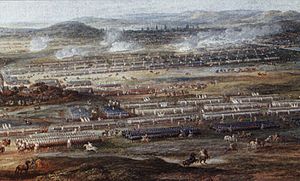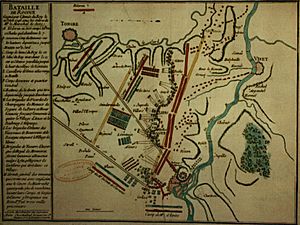Battle of Rocoux facts for kids
Quick facts for kids Battle of Rocoux |
|||||||
|---|---|---|---|---|---|---|---|
| Part of the War of the Austrian Succession | |||||||
 The Battle of Roucoux, 1746 |
|||||||
|
|||||||
| Belligerents | |||||||
| Commanders and leaders | |||||||
| Strength | |||||||
| 100,000 to 120,000 | 70,000 to 100,000 | ||||||
| Casualties and losses | |||||||
| 3,000 to 4,000 dead or wounded | 8,000-10,000 dead, wounded, or captured | ||||||
The Battle of Rocoux happened on October 11, 1746. It was a major fight during the War of the Austrian Succession. The battle took place near Liège in what is now Belgium.
A French army, led by Marshal Saxe, fought against a combined force. This force included soldiers from Britain, the Netherlands, Germany, and Austria. Their leaders were Charles of Lorraine, John Ligonier, and Prince Waldeck.
France won the battle, which helped them control the Austrian Netherlands. However, Marshal Saxe didn't get a huge, decisive victory. After the battle, both armies rested for the winter. They then got ready for more fighting in 1747.
Contents
Why the Battle Happened
The War of the Austrian Succession
The War of the Austrian Succession started in 1740. It was a big European conflict. At first, Britain was also fighting Spain in the War of Jenkins' Ear. This war was mostly in the Caribbean.
British and Dutch soldiers first fought together in the "Pragmatic Army." France officially declared war on Britain in March 1744. The Dutch Republic stayed neutral until 1747.
French Successes and Peace Talks
France won a big battle at Fontenoy in April 1745. After this, they captured important ports like Ostend, Ghent, and Nieuwpoort.
At the same time, a rebellion called the 1745 Jacobite Rising forced Britain to send troops to Scotland. In early 1746, the French took more cities like Louvain, Brussels, and Antwerp. Because of these wins, France's Foreign Minister, d'Argenson, suggested peace talks to Britain.
Allies' Situation
Even with their victories in Flanders, the French hadn't won the war completely. Britain still hoped to improve its position. After the rebellion in Scotland was defeated in April, Earl Ligonier returned. He took command of the British and German (Hanoverian) troops.
At this point, only money from Britain kept its allies in the war. Austria's main goal was to get Silesia back from Prussia. The Austrian Netherlands (modern Belgium) had been given to Austria in 1713. This was because neither Britain nor the Netherlands wanted the other to control it. The Dutch also wanted peace because the fighting hurt their trade. These reasons were important for the 1746 military campaign.
The Battle of Rocoux
Setting the Stage
The Austrian Netherlands was a flat area, about 160 kilometers wide. It had many canals and rivers. Before the 1800s, goods and military supplies were mostly moved by water. So, wars in this area were often about controlling rivers like the Lys, Sambre, and Meuse.
Between February and July 1746, the French captured Brussels, Antwerp, Leuven, and Mons. Then, they moved to towns along the Meuse River, starting with Charleroi.
In mid-July, the Allied "Pragmatic Army" got ready to defend Namur. Marshal Saxe cut their supply lines, forcing them to retreat. By late September, Namur had fallen. The Allies then moved to protect Liège, the next town on the Meuse.
Troop Positions
Most estimates say the Allies had between 70,000 and 75,000 troops. The French had a much larger force, about 110,000 to 120,000 soldiers.
The Allied army's left side was near the suburbs of Liège. Their line stretched through Rocoux to the River Jeker. The Dutch, led by Waldeck, held the left side. The British and Germans were in the middle. The Austrians, who were the largest part of the army, were on the right.
The Allied position was split by several rivers and deep ravines. This made it very hard to move troops across the battlefield. Because of this, the Austrian soldiers didn't take much part in the heavy fighting. This fighting happened mostly on the Allied left and center.
The Attack Begins
French cavalry met Austrian outposts around 6:00 PM on October 10. They then stopped for the night, camping outside Liège. The Allied commander, Charles of Lorraine, knew they were greatly outnumbered. He ordered the baggage train to cross the Meuse River. This was to allow an organized retreat if needed.
Ligonier's troops fortified the villages of Rocoux, Varoux, and Liers. Marshal Saxe decided to attack the Allied left and center. He left a small force to keep the Austrians busy on the right.
After a night of heavy rain, thick mist covered the area. So, the French didn't start the battle until the weather cleared around 10:00 AM. Their artillery then began firing on the British and Dutch positions.
At the same time, two French columns prepared a direct attack. These were led by Clermont-Tonnerre and Lowendahl. After the Liège authorities opened the town gates, a third column moved through the town. This column, led by de Contades, went around Waldeck's Dutch forces. Waldeck had to move his troops to face this new threat.
These movements delayed the main French attack until 3:00 PM. The Dutch fought strongly, especially around the village of Ance. They finally lost it after two hours of heavy fighting. Dutch cavalry counter-attacks helped their infantry pull back in good order. Waldeck took a new position behind the road to Tongeren, hoping to hold it.
Allied Retreat
A second French attack hit the British-German troops in the center. They were forced out of their fortified spots in Rocoux and Vercoux. They then regrouped further back.
Although Von Zastrow held Liers, the British and German infantry pulled back towards the Meuse. The Austrians, who hadn't been directly involved, covered their retreat. Now, Waldeck was in danger of being cut off from the right side of the army. He also had to retreat and left his new positions.
King George II later criticized Charles of Lorraine. He claimed Charles didn't support the British and Dutch enough. But Ligonier said Charles had followed the plan agreed upon by the Allied leaders the night before.
Marshal Saxe decided it was too late in the day to keep attacking. This allowed his opponents to retreat with little trouble. The British, Germans, and Dutch crossed the Meuse on three Pontoon bridges. The Austrians withdrew over the Jeker River, then headed for Maastricht.
Estimates of losses vary. The French had about 3,000 to 4,000 soldiers killed or wounded. The Allies lost between 8,000 and 10,000 soldiers. This included about 3,000 who were captured.
What Happened Next
Rocoux led to the capture of Liège. It also opened the way for an attack on the Dutch Republic. However, the Allies managed a well-organized retreat. This stopped Saxe from getting a truly decisive victory.
France began peace talks with Britain in Breda in August 1746. These talks went slowly. The British envoy, Lord Sandwich, was told to delay. Britain hoped their situation in Flanders would get better.
In January 1747, Britain agreed to pay for Austrian and Sardinian forces in Italy. They also agreed to fund an Allied army of 140,000 in Flanders. This number would grow to 192,000 in 1748.
By late 1746, Austrian forces had pushed Spanish troops out of Northern Italy. Neither France nor Spain could afford to keep fighting their campaigns. With this threat gone, Maria Theresa of Austria wanted peace. She wanted to reorganize her government. She even used British money to pay for building projects in Vienna.
Hoping to improve their position in Flanders, the Duke of Newcastle convinced his allies to try again. This led to another defeat at Lauffeld in July 1747.
Images for kids




